Virginia
| |
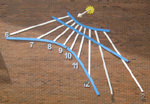 |
Newport News |
Virginia |
USA |
Vertical Dial |
Dial 862 |
| This vertical dial declines 28 degrees east, and was commissioned as educational artwork for the new Discover STEM Academy (Magruder Elementary School). The dial is 21 feet wide and 14 feet tall consisting of quarter inch by 3 inch aluminum planks for the hour lines and 4 inch aluminum pieces for the solstices and equinox lines. The hour lines are adjusted for longitude, with stainless steel Arabic numerals showing the time from 6am to 2pm at the bottom of each hour line. The gnomon is a 2 inch rod 40 inches long with a 6-inch nodus ball set back slightly from the rod end. The gnomon is held to the wall by an 18 inch yellow sun. |
| |
| |
|
Niagara Falls |
Ontario |
Canada |
Armillary Sphere |
Dial 468 |
| A small 18 to 24 inch armillary sphere. Has a traditional arrow marking the gnomon. It sits on a pedestal in the center of the herb garden. |
| |
| |
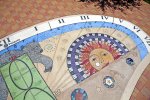 |
Niceville |
Florida |
USA |
Analemmatic Dial |
Dial 727 |
| An interactive analemmatic dial with 6x3 meter major and minor ellipse axes and built of precast concrete, tiles and glass with Roman hour numerals. Dial face markings include Ante Meridiem, Post Meridiem, astronomical symbols for days of week and constellations of the zodiac, compass rose, Sun face, Ursa Major bear constellation with Big Dipper asterism, Polaris solar cell visible at night beneath the noon mark, artistic analemma and artist inscription.
Inspired by the analemmatic dial "Keppel Henge" located at Georgian Bay, Ontario, Canada, the dial was two years in design and construction, with financial support from Ms. Dotty Blacker of Valparaiso, Florida and the NWFSC Foundation. Dial accessories include 8 and 12 foot gnomon poles with leveling clinometers allowing the dial to be used with precision for demonstration and instruction.
The dial is a focal point for geoscience instruction both in the classroom and the local community. The Science Department at NWFSC offers many courses in the geosciences that benefit from the dial, including Earth Science, Physical Science, Physical Geology, Oceanography, and Astronomy; supports baccalaureate programs in Elementary and Middle School Math & Science Education; and is frequent host to a local astronomy club. |
| |
| |
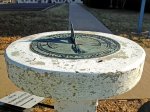 |
North Little Rock |
Arkansas |
USA |
Horizontal Dial |
Dial 737 |
| A cast bronze horizontal dial atop a concrete pedestal. The dial face includes hour lines, quarter hour marks and Roman hour numerals.
The dial face includes inscribed (not in original casting) lines that indicate the sunrise and sunset times for the longest day (L-Day VI-21), shortest day (S-Day XII-21) and equinoxes (12-H Day IX-21). |
| |
| |
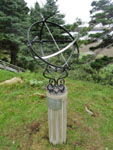 |
Northern Bay |
Newfoundland |
Canada |
Armillary Sphere |
Dial 789 |
| An approximately 24 inch diameter steel and aluminum armillary dial with wrought iron scrollwork base. The equatorial ring includes an aluminum plate inscribed with hour, half-hour and five minute marks showing time from 5 AM to 7 PM. A plaque on the pillar below shows combined corrections for EOT and longitude. The dial is mounted on a 10 inch fluted concrete pillar, reinforced with steel rebar. |
| |
| |
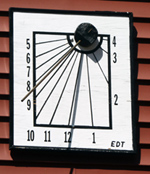 |
Norwell |
Massachusetts |
USA |
Vertical Dial |
Dial 1003 |
| This vertical declining dial is made of painted plywood with a simple white background and black hour lines and Arabic numerals. The gnomon is a brass rod without nodus. The hour lines have been adjusted for the difference between the site's longitude and the 75° W standard-time meridian. The hours are numbered as Eastern Daylight Time (EDT) instead of Standard Time, because in winter the sun is mostly low in the sky and trees in this wooded area block sunlight from reaching the sundial. Of course to obtain correct EDT, the equation of time needs to be added to the dial's time to account for the variable meridian passage of the sun. At most this amounts to -14 minutes (mid-February) or +16 minutes (early November). |
| |
| |
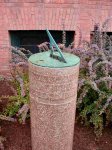 |
Norwich |
Connecticut |
USA |
Horizontal Dial |
Dial 546 |
| A well-patinaed horizontal dial placed atop a stone column. Dial sits atop a cast aggregate column. |
| |
| |
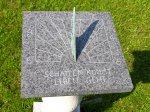 |
Norwich |
Vermont |
USA |
Horizontal Dial |
Dial 630 |
| A 12 inch square gray granite horizontal dial with bronze gnomon on a terracotta and stucco pedestal. Corrected for longitude to read EST. EOT corrections to nearest half-minute for the 1st and 15th of each month are engraved on edges of dial face. This is a private dial, not generally available for viewing. Dial sits atop a post of terracotta covered with stucco. |
| |
| |
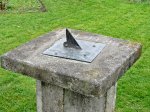 |
Oak Bay |
British Columbia |
Canada |
Horizontal Dial |
Dial 738 |
| A 10 inch square brass or bronze horizontal dial atop a 22 inch square concrete base with cross-shaped plinth 42 inches high. The natural patina developed by the corrosive sea air has reduced the contrast of the markings. Stylized Arabic hour numerals are engraved in circles. Engraved scrolls add interest but some confusion to the dial face. The dial face and gnomon are only one-eighth inch thick but remain intact. |
| |
| |
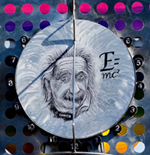 |
Oak Ridge |
Tennessee |
USA |
Vertical Dial |
Dial 1134 |
| This vertical dial is set on an 11-foot (3.4m) stand very near the front wall of the Museum. The 18-inch (46cm) dial face is eye-catching with a portrait of Albert Einstein hand engraved into stainless steel. The Equation of Time curve is used symbolically as a wave of light that in dual nature becomes a particle to create the photoelectric effect. This is not a functioning sundial even though the gnomon is set to its latitude in Oak Ridge. Created as a south facing dial, it sits facing nearly due west. The hour numbers from 6am to 6pm were uniformly placed, "with the idea that they coordinate with the gnomon and axis of the earth." They do not represent the proper hour spacing for a vertical dial, being more appropriate for an equatorial sundial.. |
| |
| |
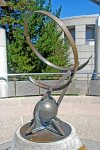 |
Oakland |
California |
USA |
Reflective Equatorial |
Dial 613 |
| One of Bill Gottesman's unique-design Renaissance dials of cast and structural bronze with a 27 inch diameter helix with a celestial-north aligned axis. Time is told by a focused beam of light that moves around the helix throughout the day. The light beam is reflected from a long cylindrical unsilvered mirror in a structure that supports the helix. A sliding time scale within the helix can be adjusted for EOT and DST and includes longitude correction. Once this scale is adjusted for date, the dial shows civil, or clock, time. The dial base is cast bronze allowing adjustment for latitude and placed on a concrete pedestal. |
| |
| |
 |
Oakland |
California |
USA |
Sculpture/Artwork |
Dial 307 |
| Bronze sundial sculpture by Robert Paine. The sundial was donated to University High School in 1927 by Sara Bard Field in honor of her son Albert, who was killed in 1917 in an automobile accident. Albert was the high school senior class president in 1917. His mother Sara was a leading suffragist on the West Coast. The High School has been renovated and now used by Children's Hospital Oakland Research Institute (CHORI). |
| |
| |
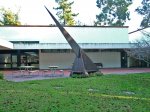 |
Oakland |
California |
USA |
Horizontal Dial |
Dial 236 |
| Large horizontal dial, with steel gnomon 26 ft. (8m) long, 16 ft. (5m) high, and 6 ft. (2m) wide. It looks like a sculpture of three interlocking triangles. The triangles of 2-inch thick Cor-Ten steel plates create the dial's gnomon and supporting structure. Overall, the sundial weighs about 5,700 pounds. The dial sits in a courtyard where the only hour markers are placed on the lawn and brick patio around the dial. EOT values for every 5 days are shown on the north face of the support. |
| |
| |
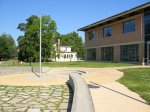 |
Oberlin |
Ohio |
USA |
Sun Alignment |
Dial 63 |
| When is a flag pole more than a flag pole? When it has cement walkway curved for the summer solstice, a path for the winter solstice and a distinguishing straight cement line for the spring and fall equinox. This dial has no hour markers, and is intended to show the seasons. The tip of the flag pole will follow these lines at the appropriate day of the season. |
| |
| |
 |
Oberlin |
Ohio |
USA |
Vertical Dial |
Dial 219 |
| Once, high on the physics building south wall was a student made vertical dial. The 5'x8.5' resin coated particle board made by Mark Kearns in 1979 had curved hour lines to account for the equation of time, declination of wall, and offset from standard meridian. This dial has not been on display for some time. Perhaps some student would create a new dial. The brick wall is an excellent location. |
| |
| |
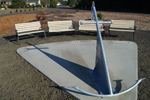 |
Ocean Shores |
Washington |
USA |
Horizontal Dial |
Dial 842 |
| This large horizontal dial has a gnomon in the shape of an anchor and concrete minimalist dial surface in the shape of a triangle, keeping the theme of the location "Triangle Park". Three time Arabic hour numbers of 9, 12 and 3 are embedded into the concrete slab and two other time marks of 6am and 6pm are on separate pads located outside the main dial area. |
| |
| |
 |
Ogunquit |
Maine |
USA |
Horizontal Dial |
Dial 1111 |
| This is an elegant commercially made bronze horizontal dial about 18-inch (.46 cm) in diameter. The Chapter Ring has hours from 5am to 7pm, divided in quarter hours. Hours are marked in Roman Numerals from VI to VI. A bird sits profile in the gnomon, filling the space beneath the style. The gnomon foot is accurately placed to a line between VI-VI, but the gnomon angle was not measured. The dial rests on a polished brown granite pillar. At the base of the pillar is a small bronze plaque. |
| |
| |
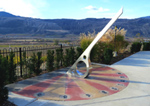 |
Oliver |
British Columbia |
Canada |
Horizontal Dial |
Dial 809 |
| A lovely horizontal dial with an 8-foot high stainless steel gnomon. The hour lines are done as colorful alternating red and cream segments set in a 8-foot radius semi-circle. The gnomon is triangular in cross section with a single thin edge casting the shadow. The dial hour numbers are set for daylight, since all of the winery's 100,000 annual visitors are seasonal, coming when Pacific Daylight Time is in place. |
| |
| |
 |
Olympia |
Washington |
USA |
Horizontal Dial |
Dial 319 |
| John W. Elliot, a Seattle master craftsman designed and execute the Territorial Sundial. The 6 foot dial is hand-hammered in brass with a bronze rod gnomon. The dial plate has eight bas-relief panels depicting events in Washington State's history including the discoveries of Captain George Vancouver in 1792, the Medicine Creek Treaty between the US and Puget Sound Native Americans in 1854 and the first railroad to Puget Sound, built in 1883. The dial rests on a large slab of Wilkenson sandstone, the same material used in the nearby State Library, supported by four, one foot nine inch tall piers. |
| |
| |
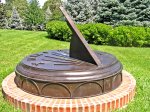 |
Omaha |
Nebraska |
USA |
Horizontal Dial |
Dial 598 |
| A 7.5 foot diameter horizontal dial of water jet cut sheet bronze and cast bronze side molding with a 45 inch high gnomon. Very large Roman numerals show hours from 10 AM to 5 PM in Daylight Saving Time with longitude correction. The bronze dial rests on a short concrete and brick pedestal. |
| |
| |
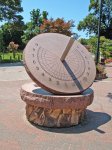 |
Omaha |
Nebraska |
USA |
Equatorial Dial |
Dial 653 |
| A five foot granite equatorial dial on a granite and stone pedestal with a 5 inch diameter stainless steel gnomon extending through the dial face. Arabic hour numerals for 4 AM to 9 PM are shown on the north face and for 6 AM to 7 PM on the south face. Dial is within the Henry Doorley Zoo which may require admission to see the dial, which is a memorial to Marcia Bekins Shepard. Dial sits on a granite disk atop a mortared stone pedestal. |
| |
| |
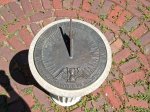 |
Omaha |
Nebraska |
USA |
Horizontal Dial |
Dial 654 |
| A cast bronze horizontal dial with Roman hour numerals and fifteen-minute marks on a pedestal in a stone courtyard. Dial face includes a depiction of an hour glass with wings and a motto, GROW OLD ALONG WITH ME THE BEST IS YET TO BE. Dial sits on a three foot high fluted circular cast pedestal. |
| |
| |
 |
Omaha |
Nebraska |
USA |
Armillary Sphere |
Dial 655 |
| A five foot diameter stainless steel armillary dial with central gnomon rod and equatorial, horizon, meridian and equinoctial colure rings. CST and CDST hours are marked with Arabic numerals. The dial rests on a polished black granite base of two supporting arms. The dial is located at the center of the Robert H. Storz Family Rose Garden within Lauritzen Gardens. Dial sits atop a two-arm polished black granite base approximately 4 feet tall.
Viewing the dial requires paid admission to the Gardens. |
| |
| |
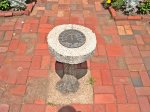 |
Omaha |
Nebraska |
USA |
Horizontal Dial |
Dial 665 |
| A bronze horizontal dial with 5 AM to 7 PM hour lines and Roman numerals. Placed on a cast concrete pedestal 3 feet high in the form of a tree trunk with an image of a bird cast into the base. |
| |
| |
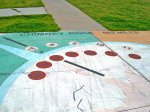 |
Omaha |
Nebraska |
USA |
Analemmatic Dial |
Dial 667 |
| A 20 foot square dial painted on concrete. Painted hour markers in two arcs for ST and DST include longitude correction. A nearby plaque provides instructions for use of dateline but has the hour marker arcs miss-labeled for ST and DST. |
| |
| |
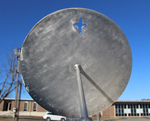 |
Opp |
Alabama |
USA |
Equatorial Dial |
Dial 893 |
| This 2-foot diameter equatorial disk is of quarter-inch aluminum plate with hourly time marks cut through with slots. Shorter slots mark half our and fifteen minute intervals. The noon mark is surrounded by short holes made at five minute intervals. At the top of the dial is a cut fleur de lis. |
| |
| |
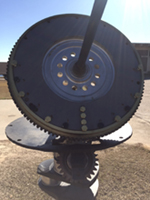 |
Opp |
Alabama |
USA |
Equatorial Dial |
Dial 895 |
| An equatorial sundial made of diesel engine parts by the students of Lureen B. Wallace Community College, under the guidance of Eddie Spann, instructor for diesel and heavy equipment and designed by the college president, Dr. Herbert Riedel. The stand is a crankshaft from a Cummins engine, while the dial base and dial faceplate are flywheels. The gnomon is a heavy duty diesel cylinder liner puller. The gear teeth on the faceplate mesh with a small gear to allow easy adjustment for the equation of time. Hours are marked by bolts, and on the winter side are painted hour numbers. |
| |
| |
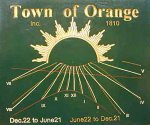 |
Orange |
Massachusetts |
USA |
Vertical Dial |
Dial 527 |
| A vertical sundial built from Eastern White Pine local-grown timber. The dial face is 35x44 inches and the gnomon is a 3 inch long aluminum rod. Hour lines include analemmas and the spring and fall lines are painted different colors with corresponding dates identified. Solstice and equinox lines are shown. |
| |
| |
 |
Orlando |
Florida |
USA |
Horizontal Dial |
Dial 37 |
| This plain dial formed on a concrete base has an elegant gnomon, designed with an interior curve and oval. But alas, don't go to Florida to find it. Sometime in 2013 as Harcourt closed its Florida office, the new tenet had no use for the sundial and had it scheduled for demolition. |
| |
| |
 |
Orlando |
Florida |
USA |
Pillar Dial |
Dial 89 |
| Reconstruction of a 4-sided pillar dial. |
| |
| |
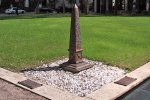 |
Orlando |
Florida |
USA |
Obelisk or Vertical Gnomon |
Dial 294 |
| Bronze, granite An obelisk which, at the noon hour, will cast a shadow on a noon mark plaque positioned on the ground. |
| |
| |
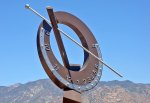 |
Oro Valley |
Arizona |
USA |
Compound Dial |
Dial 713 |
| A massive, 24 foot [7.3m] tall combination almost-vertical and calendrical dial facing southwest so that northeast bound traffic can easily view the dial. The 13 foot [4m] diameter vertical ring dial of welded, zinc-coated steel declines 45 deg west and reclines 12 deg from vertical. The 3 inch [7.6cm] diameter, 20 foot [6m] long polar-pointing gnomon rod is supported in space by a 10 inch [25cm] diameter support tube with a cone nodus on the bottom end. The vertical dial shows longitude-corrected MST with hour and half-hour marks and Arabic numerals on the outer stainless steel chapter ring. |
| |
| |
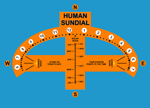 |
Oro Valley |
Arizona |
USA |
Analemmatic Dial |
Dial 871 |
| This analemmatic sundial is painted on concrete. It is similar to John Carmichael's human sundial at Flandrau Planetarium at the University of Arizona. The orange background was painted by hand with acrylic paint on top of the blue acrylic court surface. Lettering and other markings were painted with Rustoleum spray enamel using stencils from Stencilease.com. Final touch up painting was done by hand. It took a three man team ten days to paint. It's quarter hour time marks are longitude corrected and shows Standard Time when readings are adjusted using the Equation of Time. It includes a central Date Line for standing, using monthly and weekly marks. There is a Solar Noon mark, and Bailey Points to indicate the direction of sunrise and sunset. |
| |
| |
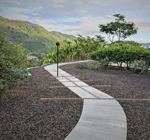 |
Orosi Valley |
Cartago |
Costa Rica |
Obelisk or Vertical Gnomon |
Dial 761 |
| A 25 foot long point-in-space or nodus dial. The horizontal dial face is cuartilla (crushed stone). The 8 AM - 4 PM hour lines are red adoquines (bricks) and the noon hour line is lodged between gray adoquines. The dial equinox line is a row of gray adoquines. Solstices are identified by the curve formed by the tips of the hour lines. The gnomon atop a 1.8 m high vertical rod is a 21 cm diameter sphere, hand carved out of gabbro, a rock formed from molten magma. It is a replica of bolas de piedra (stone balls) created a thousand years ago by the local Diquis indigenous people and discovered in 1930. |
| |
| |
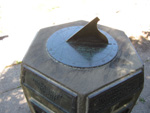 |
Ottawa |
Ontario |
Canada |
Horizontal Dial |
Dial 827 |
| This sundial is a memorial for W T Macoun. The dial is a simple bronze horizontal sundial, about 12 inches in diameter. It shows solar time with hour lines from 4 am to 8 pm. Hour marks are Roman numerals. The design accounts for the thick gnomon. The stone octagonal base is about 40 inches high |
| |
| |
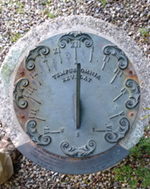 |
Ottawa |
Ontario |
Canada |
Horizontal Dial |
Dial 833 |
| A garden variety round horizontal sundial about 12 inches in diameter. It looks like a bronze casting with iron staining from steel bolts. Hours marks only from VI to VI (6 am to 6 pm). The dial is located in a very shaded spot close to a building and surrounded by trees. Ornamental. Dial plate has inscription "Tempus Omnia Revelat" (Time Reveals All). |
| |
| |
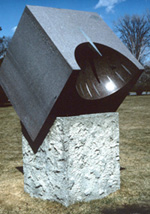 |
Ottawa |
Ontario |
Canada |
Globe or Hemispheric |
Dial 449 |
| This hemispherium dial is a dramatic modern sculpture. The 32 inch quarter hemisphere is carved into the edge of a 40 inch cube of dark granite tilted to conform to its latitude of 45.5° , and set upon a rough concrete pedestal of slightly smaller dimension. The gnomon is a |
| |
| |
 |
Ottawa |
Ontario |
Canada |
Vertical Dial |
Dial 1106 |
| A 1.2m (47 in) wide by 0.7m (28 in) high vertical sundial that declines 5 degrees to the west of south. Hour lines are longitude-corrected. The dial face was laser cut from a large 3mm (1/8 in) thick plate of steel and powder coated with white paint. The cut-out pieces of the steel sheet were beautifully assembled together and mounted near the front door of the house. A conic gnomon was selected to point to the hour lines from 9am to 6pm summer hours. |
| |
| |
 |
Ottawa |
Ontario |
Canada |
Sun Alignment |
Dial 739 |
| A memorial alignment dial that illuminates the headstone of the Unknown Soldier on Remembrance Day, November 11 at 11:00 AM, commemorating the end of World War I. Remembrance Day is celebrated on the 11th hour of the 11th day of the 11th month of each year. |
| |
| |
 |
Ottawa |
Ontario |
Canada |
Horizontal Dial |
Dial 10 |
| A bronze 12 inch diameter horizontal dial with hour lines from 4 AM to 8 PM and engraved Roman hour numerals and compass rose. This restoration was donated by Thomas Ritchie who remembered from his youth that the original dial was accidentally destroyed during the construction of the Parliament Library in 1872. The restored dial was unveiled May 19, 1921 by the Governor General, Sir Victor Cavendish, Duke of Devonshire.Dial sits atop light granite pillar approximately 18 inches diameter and 40 inches high. |
| |
| |
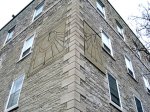 |
Ottawa |
Ontario |
Canada |
Vertical Dial |
Dial 127 |
| Two vertical declining dials declining 58.1° west and 31.9° east on adjacent sides of the south corner of the Sisters of Charity of Ottawa Mother House. The southwestern dial is approximately 7x8 feet (2.1m x 2.4m) and the southeastern dial is approximately 7x4 feet (2.1m x 1.2m) The dials are of gray plaster with black painted iron gnomons (the southwestern one being slightly bent). The southwestern dial has hour lines from 10 AM to 7 PM and the southeastern dial has hour lines from 7 AM to 3 PM. These dials predate the use of time zones and show local solar time. Mayall in his book on Sundials (p. 229) erroneously described this dial as on Mint Tower. Rather, Elisabeth Bruyere, Foundress of Sisters of Charity of Ottawa, wrote "In the course of the same winter, Fr. Allard had built a double sundial of great dimension on the southwest angle of the house (corner of Bolton and Sussex streets) which, even today, continues to give the correct time, as it did in Bruyere's time; she greatly appreciated the convenience. The work presupposed an advanced knowledge of mathematics and astronomy. It was the first of its kind in Canada." |
| |
| |
 |
Ottawa |
Ontario |
Canada |
Horizontal Dial |
Dial 230 |
| A large horizontal floral dial approximately 20 feet in diameter. Large circular area on ground forming the dial face with gravel and flower-beds between the hour lines. The flowers are annuals, best seen in the summer blooming season. Update June 2018: The dial has been refurbished with a new, accurately placed gnomon and wonderful bright flowers. |
| |
| |
 |
Owasso |
Oklahoma |
USA |
Analemmatic Dial |
Dial 961 |
| This is a nicely done 12 x 6 foot analemmatic. The time ellipse is white concrete with black hour marks using Roman numerals. Time is adjusted for longitude and daylight savings time. The walkway has black month marks and an explanation plaque. |
| |
| |
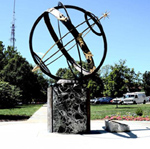 |
Oxford |
Ohio |
USA |
Armillary Sphere |
Dial 103 |
| A 6 foot armillary sphere sitting on a marble column supported by a ring of turtles. The armillary has equatorial, meridian, polar and equatorial rings, plus the arctic and antarctic rings near the poles. Along the outside of the equatorial ring are golden figures, marking the houses of the zodiac. On the inside of the equatorial ring are Roman numerals marking the hours. The armillary was a gift to the university on its 50th anniversary by the Miami chapter of Delta Delta Delta sorority. The plaque given coordinates of latitude and longitude of the dial that are slightly different than those from Google Earth, which are the coordinates given here. |
| |
| |
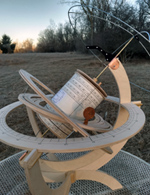 |
Oxford |
Michigan |
USA |
Armillary Sphere |
Dial 1093 |
| This is an armillary of unusual construction, mostly of nicely prepared wood. The base has three legs set out at 120°, holding horizon ring approximately 1m (39 inches) in diameter. An adjustable meridian ring for any latitude holds a brass polar axis rod and a cylinder for reading various time scales. The horizon ring has azimuths marked at every 5° and labelled every 15°. Interior to the horizon ring is the earth's celestial equator marked in right ascension in both hours and degrees. The equatorial ring ais connected to an umbrella-like portion of the north celestial pole, showing the position of the Big Dipper and Polaris. |
| |
| |
|
Palisades |
New York |
USA |
Equatorial Dial |
Dial 410 |
| An equatorial dial in bronze. Has analemma at the noon hour mark. Lamont-Doherty Sundial Fountain. |
| |
| |
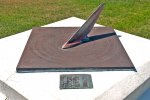 |
Palm Beach |
Florida |
USA |
Horizontal Dial |
Dial 637 |
| A bronze horizontal dial approximately 24 inches square on a painted masonry pedestal. Inner hour circle shows Arabic numerals for standard time and outer hour circle shows Roman numerals for local time. Dial face includes cardinal direction marks and coordinates. An EOT table is provided in an adjacent bronze plaque atop the pedestal. Dial is located on the entrance walkway to the Flagler Museum, formerly known as Whitehall, Henry Flagler's private home. Museum is open to the public but requires an entry fee. |
| |
| |
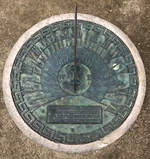 |
Palo Alto |
California |
USA |
Horizontal Dial |
Dial 900 |
| This horizontal bronze dial is 14.5 inches in diameter, mounted on a fluted pedestal. The gnomon angle is set for the latitude and is 5 5/8 inches tall. Graceful hour lines extend from 5am to 7pm marked by Roman numerals. It is delineated only with half-hour lines. Surrounding the dial face is a zig-zag decoration. |
| |
| |
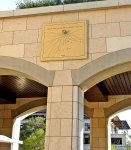 |
Palo Alto |
California |
USA |
Vertical Dial |
Dial 482 |
| A vertical declining dial approximately 45 x 55 inches. Made of aluminum and brass. Shows the hours from 8 am to 5 pm using analemmas. Analemmas are bounded by the summer and winter solstices and a straight line through them shows the equinox. Daylight time is shown using Roman numerals, with standard time shown in Arabic. In keeping with the motto, a simple equation is written on the dial face, d/dt is not equal 0.
Designer Ronald Bracewell used an oculus, a disk with a central hole, standing 8 cm in front of the dial face. The disk casts a shadow with a bright sunlight dot to indicate both time and season. Hour lines include longitude correction.
This has been relocated; it was previously hanging free below a south facing wall, facing the Terman Engineering Building. Dial is now located on the wall of a covered walkway area. |
| |
| |
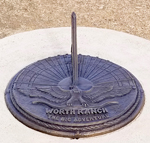 |
Palo Pinto |
Texas |
USA |
Horizontal Dial |
Dial 890 |
| The 21 inches in diameter sundial started as a sculpture. A call went out to the boy and girl scouts (and alum men and women) to contributed fossils, and other artifacts. This included an arrowhead found at camp. These objects were incorporated into the finished wax, with the arrowhead embedded on the style edge at the very tip of the gnomon. A mold was taken of the completed sculpture and used to create a casting wax replica of the sculpture. |
| |